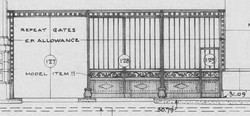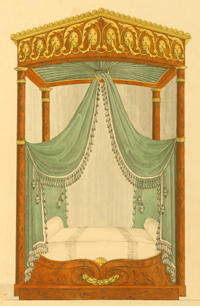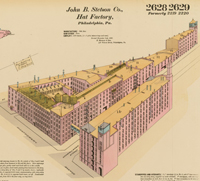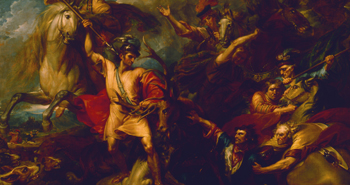|
Greetings,
Work has continued on the Athenaeum Strategic Plan, but we
still need your help. Please either
fill out the online form below or a paper version available at Susan Gallo’s
desk in the Athenaeum. Also, please
make a reservation to attend one of the last two members’ focus groups:
Wednesday, May 14th,
10:00 am
Monday, June 2nd, 5:30
pm
ONLINE
SURVEY
Remember, this is your opportunity to share ideas,
questions, and suggestions about your Athenaeum.
GALLERY TALK REMINDER:
Wednesday, May 28th, 5:30 pm.
Meet John Blatteau and Sandra Tatman in the Athenaeum gallery.
RSVP to Susan Gallo 215-925-2688 or sgallo@philaathenaeum.org
Banner Image: Detail from King Alexander and
the Stag. Charles Robert Leslie after Benjamin West, 1814. Located on
the Grand Stair of the Athenaeum.
Athenaeum Receives Grand Jury Building
Award From Preservation Alliance
 The
Athenaeum was named co-winner of the Preservation Alliance’s Grand Jury Award
for the Cret-Yellin Gate at
Thomas
Jefferson
University
Hospital
. The Award was one of eleven given by the Preservation Alliance to honor
exemplary restoration projects throughout Philadelphia. Originally
designed by Paul Philippe Cret for the Federal Reserve Bank building at 10th
& Chestnut Streets, the
iron gate
was fabricated by the Samuel Yellin Iron Works.
Beginning in 2007, 20th Century Preservation, LLC used original
architectural drawings in the Athenaeum’s Cret collection to ensure the
accuracy of their restoration of the gate. Recognizing the importance of the
archival collections, 20th Century Preservation, LLC and the Samuel Yellin
Metalworkers graciously shared the award with the Athenaeum and the University
of
Pennsylvania Architectural Archives. The
Athenaeum was named co-winner of the Preservation Alliance’s Grand Jury Award
for the Cret-Yellin Gate at
Thomas
Jefferson
University
Hospital
. The Award was one of eleven given by the Preservation Alliance to honor
exemplary restoration projects throughout Philadelphia. Originally
designed by Paul Philippe Cret for the Federal Reserve Bank building at 10th
& Chestnut Streets, the
iron gate
was fabricated by the Samuel Yellin Iron Works.
Beginning in 2007, 20th Century Preservation, LLC used original
architectural drawings in the Athenaeum’s Cret collection to ensure the
accuracy of their restoration of the gate. Recognizing the importance of the
archival collections, 20th Century Preservation, LLC and the Samuel Yellin
Metalworkers graciously shared the award with the Athenaeum and the University
of
Pennsylvania Architectural Archives.
Photo: Elevation of 10th St. gate
of the Federal Reserve Bank of Philadelphia, 1932. Cret Collection.
Hidden Treasure: Samuel J. Dornsife
Interior Design Collection
 In
1976 Dr. Samuel J. Dornsife, ASID, transferred
his collection of several thousand items to The
Victorian Society in America so that it could be permanently housed
under the care of the Athenaeum where it is available for supervised research,
exhibition, and publication. The
Samuel J. Dornsife Collection of The Victorian Society in
America allows researchers a unique opportunity to access this rich
collection, which represents the lifetime collecting of Dr. Dornsife, a design
historian from
Williamsport
,
PA.
The collection can be found in the Athenaeum's library
catalog by typing Dornsife/VSA into the search box. This
will allow you to access over 2000 records for the Dornsife Collection,
including, for example, John Bullock’s The
American Cottage Builder of 1854 and Edward Kemp’s How
to Lay Out a Garden of 1860. In
1976 Dr. Samuel J. Dornsife, ASID, transferred
his collection of several thousand items to The
Victorian Society in America so that it could be permanently housed
under the care of the Athenaeum where it is available for supervised research,
exhibition, and publication. The
Samuel J. Dornsife Collection of The Victorian Society in
America allows researchers a unique opportunity to access this rich
collection, which represents the lifetime collecting of Dr. Dornsife, a design
historian from
Williamsport
,
PA.
The collection can be found in the Athenaeum's library
catalog by typing Dornsife/VSA into the search box. This
will allow you to access over 2000 records for the Dornsife Collection,
including, for example, John Bullock’s The
American Cottage Builder of 1854 and Edward Kemp’s How
to Lay Out a Garden of 1860.
Illustration from Meubles et objets de gout, 1796-1830 : 678 documents tirés des journaux de modes et de la "Collection" de La Mésangère.
Paris : Librairie des arts décoratifs, A. Calavas, editeur, 68, rue Lafayette, [ca. 1914].
Samuel J. Dornsife Collection of the Victorian Society in America at the
Athenaeum of Philadelphia.
Coffee Day: Monday June 2, 9:30 AM - 4:00
PM
 The
farewell for Ellen Rose presented us with an opportunity to have a casual,
congenial day for visiting with other members and staff.
The Athenaeum now inaugurates a new tradition where one day per month,
usually the first Monday, we will
offer light refreshments, coffee and tea, in the Members’ Reading Room.
Come and meet your friends here. Make
new friends. Talk with the staff,
and especially get to know Jill Lee, Ellen’s successor.
We expect this date to coincide with “new book week” so that you will
already have the date on your calendar. The
farewell for Ellen Rose presented us with an opportunity to have a casual,
congenial day for visiting with other members and staff.
The Athenaeum now inaugurates a new tradition where one day per month,
usually the first Monday, we will
offer light refreshments, coffee and tea, in the Members’ Reading Room.
Come and meet your friends here. Make
new friends. Talk with the staff,
and especially get to know Jill Lee, Ellen’s successor.
We expect this date to coincide with “new book week” so that you will
already have the date on your calendar.
Photo
by Jim Carroll.
Greater Philadelphia GeoHistory Network
 The
Athenaeum is host to a rapidly growing website that, like PAB
before it, will forever change the way building research in
Philadelphia
is conducted. In 2005, with a $50,000 pilot grant from the Andrew W. Mellon
Foundation, the Athenaeum, in cooperation with more than 30 local
special-collections libraries, created the Greater Philadelphia GeoHistory
Network. GPGN makes accessible a variety of geographic research source materials
that, because of their rarity and fragile nature, have up till now been
extremely difficult to review in person. These
include nearly 500 large format map and atlas plates that range in date from
1858 through 1962. Scanned at the
Athenaeum’s Regional Digital Imaging Center
(RDIC), these high resolution images are available in the same viewing system
developed for PAB.
In addition to maps, there are nearly 3000 full-color plates from the
Free Library of Philadelphia’s Hexamer General Surveys. The surveys, prepared
between 1865 and 1899, each document
an industrial site in the
Philadelphia
area with a perspective drawing, plot plan, and detailed textual description of
the products and operations of the plants. Also
available on the GeoHistory site are full text digitized versions of the 1856,
1858, 1861, and 1866 Philadelphia City Directories, which contain alphabetical
listings of the city’s residents featuring address, occupation, and race. RDIC
continues to scan and post geographical material to the site and expects to add
at least 500 additional images, including early aerial photos of the city, within
the next year. The GeoHistory Network can be visited at www.philageohistory.org The
Athenaeum is host to a rapidly growing website that, like PAB
before it, will forever change the way building research in
Philadelphia
is conducted. In 2005, with a $50,000 pilot grant from the Andrew W. Mellon
Foundation, the Athenaeum, in cooperation with more than 30 local
special-collections libraries, created the Greater Philadelphia GeoHistory
Network. GPGN makes accessible a variety of geographic research source materials
that, because of their rarity and fragile nature, have up till now been
extremely difficult to review in person. These
include nearly 500 large format map and atlas plates that range in date from
1858 through 1962. Scanned at the
Athenaeum’s Regional Digital Imaging Center
(RDIC), these high resolution images are available in the same viewing system
developed for PAB.
In addition to maps, there are nearly 3000 full-color plates from the
Free Library of Philadelphia’s Hexamer General Surveys. The surveys, prepared
between 1865 and 1899, each document
an industrial site in the
Philadelphia
area with a perspective drawing, plot plan, and detailed textual description of
the products and operations of the plants. Also
available on the GeoHistory site are full text digitized versions of the 1856,
1858, 1861, and 1866 Philadelphia City Directories, which contain alphabetical
listings of the city’s residents featuring address, occupation, and race. RDIC
continues to scan and post geographical material to the site and expects to add
at least 500 additional images, including early aerial photos of the city, within
the next year. The GeoHistory Network can be visited at www.philageohistory.org
Photo: Detail
from Hexamer General Survey #2628-2629, John B. Stetson Hat
Factory, Map Collection, Free Library of Philadelphia.
In The Next
Issue: Art Bound, our summer exhibition, opens June
16th.
|

